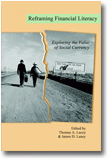
Reframing Financial Literacy
Exploring the Value of Social Currency
Edited by:
Thomas A. Lucey, Illinois State University
James D. Laney, University of North Texas
Published 2012
Scholarship related to financial and consumer education largely concerns itself with the acquisition, management, and growth of financial resources. In a global setting that witnesses increasing competition for natural resources, along with diminishing appreciation for human rights, a challenge for financial and consumer educators involves developing foundation for bettering individual wealth in manners that respect all members of a global society.
Reframing Financial Literacy fills this need by providing literature that examines a broad view of financial literacy by connecting financial practice with issues of citizenship, along with personal and professional identity. It relates these issues to educational theory and practice to provide the reader with information about the relevance of improving social worth, while bettering financial wealth.
Boasting 14 previously unpublished chapters from an international slate of authors, and classroom adaptable lesson plans for each chapter, Reframing Financial Literacy will interest both teachers and researchers with its exciting classroom activities and its provocative content. This is a must work that no education professional should be without.
CONTENTS
Foreword, Mark C. Schug. Introduction. SECTION I: CONCEPTIONS OF FINANCIAL LITERACY, CITIZENSHIP, AND IDENTITY. Connecting Financial Literacy and Political Literacy Through Critical Pedagogy, Paul R. Carr. Garbage Trucks and Deposit Slips: The Disconnect Between Life Experiences and the Economics Curriculum of South Africa, Benjamin R. Wellenreiter. Conceptualizing Financial Morality, Thomas A. Lucey. Young Canadian Women’s Financial Literacy, Vicki A. Green. Understanding African American Wealth Attainment: Implications for Leaders, Andrea N. Johnson. Comparing Undergraduate and Graduate Students’ Perceptions of Financial Morality, Alan B. Bates and Thomas A. Lucey. Moral Responsibility and Leadership: How Managers Deal with Practical Moral Conflicts, Jennifer Loew. Intersections of Identity and Ideology in Learning About Financial Capability, Valerie Farnsworth. SECTION II: EDUCATIONAL ISSUES. A Sense of Values: Developing Financial Capability in Scottish School Curricula, Cathy Fagan. The Efficacy of Financial Education in the Early Grades: Results From a Statewide Program, Weiwei Chen and Julia A. Heath. Using Technology to Develop a Broad Understanding of Financial Literacy Among K-12 Students, Jeffrey J. Sanson and Phillip J. VanFossen. Mapping Financial Futures and Developing Social Capital: Decision-Making About Career, Specialization, and Interest Rates, Mary Frances Agnello and Andrea L. Knapp. Using Art and Community Investigation to Motivate Preservice Teachers’ Learning and Teaching of Social and Economic/Financial Justice Issues, Thomas A. Lucey and James D. Laney. Home Interactions, in the Context of Learning About Numbers 1-100: How Do Romanian Parents Teach Place Value to their Children? Madalina Tanase. About the Authors.
-
Paperback978-1-61735-719-0
Web price: $45.04 (Reg. 52.99)
-
Hardcover978-1-61735-720-6
Web price: $80.74 (Reg. 94.99)
- eBook978-1-61735-721-3

- BUS027000 - BUSINESS & ECONOMICS: Finance
- EDU013000 - EDUCATION: Finance
- EDU037000 - EDUCATION: Research
-
 (Re)Envisioning Social Studies Education Research
Current Epistemological and Methodological Expansions, Deconstructions, and Creations
(Re)Envisioning Social Studies Education Research
Current Epistemological and Methodological Expansions, Deconstructions, and Creations
-
 American Educational History Journal - Golden Anniversary Edition
Volume 50 Numbers 1 & 2
American Educational History Journal - Golden Anniversary Edition
Volume 50 Numbers 1 & 2
-
 Distance Learning
Volume 20 #3
Distance Learning
Volume 20 #3
-
 Distance Learning
Volume 20 #4
Distance Learning
Volume 20 #4
-
 Faculty Development
Achieving Change Through Action Research
Faculty Development
Achieving Change Through Action Research
-
 Qualitative Research With Diverse and Underserved Communities
Qualitative Research With Diverse and Underserved Communities
-
 Quarterly Review of Distance Education
Volume 24 #1
Quarterly Review of Distance Education
Volume 24 #1

